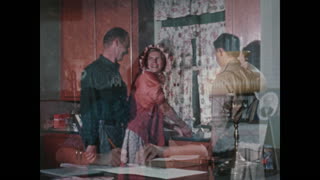This 1960 U.S. Department of Agriculture (USDA) film shows the progress made by the Rural Electrification Administration (REA), in providing power to rural America. The REA is the former name of the Rural Utilities Service, a U.S. government agency that funds rural cooperatives to provide power to rural areas. The film begins with an image of electrical power lines (0:16), while noting that “as recently as 1935, 9 of 10 farmers were without electricity.” Two electrical workers on a farm power line (1:00). Beneficiaries of the REA program are shown: Sarah Lee Pruitt, a poultry farmer (1:37); Dan Walker, a dairy farmer (1:42), Ernie Thomas, electric cooperative manager (1:45), Ed Barnes, co-op lineman (1:51), Al Hansen, rural mailman (1:56). An REA General Electric meter showing kilowatt hours (2:31). Black-and-white footage of Sarah Lee feeding hens before rural electrification (3:35), using a hand water pump, and a man plowing with donkeys in a field. Sarah Lee’s mother feeds pigs at a trough (4:24); her family eats grits and salt pork for dinner since there is no refrigeration and warms themselves by a wood stove (4:45). A ceiling light turns on in the house (5:10) and the film turns to color; Sarah Lee’s mother flicks a light switch and uses an electric iron (6:00). Sarah Lee’s cousin, Louise Phelps, reads by an electric lamp (6:31). Joe Kelly, smoking a pipe, plugs in an electric lamp (6:39). The film shows benefits of rural electricity: running water (6:55), studying by lamplight (7:09), kids drinking from a water fountain (7:17), electricity at a church service (7:45). Flocks of hens at a poultry farm (8:09); an electric feed mixer (8:28); eggs laid by electric light (8:47); a Vent-O-Matic fan (9:00); an electric egg grader (9:18). Sarah Lee delivers cardboard boxes of eggs (9:55) and waves to Charlie Holmes at the bank. A food freezer (10:58); bathtub with hot and cold water (11:02); electric heater (11:06); child sleeping with an electric blanket (11:13). Sarah Lee’s niece unloads an electric dishwasher (11:34). In Adams County, Wisconsin, Dan Walker, a dairy farmer and member of the Adams Electric Cooperative, shows how REA has benefited him. Walker milks cows with an electric milker (11:58), reads the electricity meter (12:57), and mails a check to pay his electric bill. At 13:57, rural mailman Al Hansen’s story starts. Hansen drives and delivers mail to Bert Shannon, a senior at agricultural engineering school (14:30); Hansen says more kids stay on family farms due to electricity. An air conditioner being delivered to Ferguson farm (14:49). Business owners are shown benefitting from rural electricity: Dr. Wiliams, a country doctor (15:00); Paul Jarnigan, dress factory owner (15:18). Women work at sewing machines in the dress factory (15:36). A National Capital Storage & Moving Co. truck (16:16); Adams Electric Cooperative offices (16:28). Ernie Thomas, an electric cooperative manager in Montana, explains his story at 16:49. Thomas flies a preventative maintenance route to patrol electricity lines (17:40), including over the Peterson wheat farm (18:15) and Ted Forester’s cattle farm (19:09). Electric motors to pump water for cattle and heaters to keep it from freezing (19:26). Piglets under an infrared heat lamp (19:57). Thomas flies over herds of sheep (20:24), a new school on an Indian reservation (20:37), an oil refinery (21:12), and remote warning outposts for the national defense system (21:35). Thomas visits rancher Hal Murray’s ranch to provide more electricity (22:45). An F.W Woolworth sign (23:30). A snowstorm creates a power outage (24:03); the previously shown electric appliances stop working. Crews fix the malfunctioning power lines (24:30); the electricity resumes. The film ends with a dedication to rural electric cooperatives funded by REA loans (27:07). Produced by Motion Picture Service USDA.
Motion picture films don’t last forever; many have already been lost or destroyed. For almost two decades, we’ve worked to collect, scan and preserve the world as it was captured on 35mm, 16mm and 8mm movies — including home movies, industrial films, and other non-fiction. If you have endangered films you’d like to have scanned, or wish to donate celluloid to Periscope Film so that we can share them with the world, we’d love to hear from you. Contact us via the weblink below.
This film is part of the Periscope Film LLC archive, one of the largest historic military, transportation, and aviation stock footage collections in the USA. Entirely film backed, this material is available for licensing in 24p HD, 2k and 4k. For more information visit http://www.PeriscopeFilm.com


